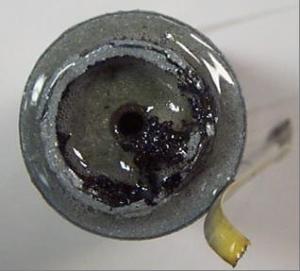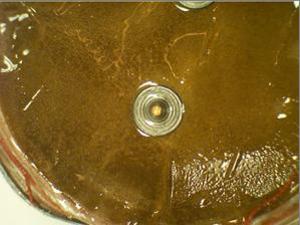Large Electrolytic Capacitor
Gideon Analytical Laboratories received an Aerovox Z26P6045M21 45uF 600V for failure analysis. No data was given on the capacitor. The capacitor was tested and found open. It did not take a charge when a voltage was applied. The capacitor was also under gas pressure and this gas was carbon dioxide. The top portion of the capacitor after it was removed showed a phenolic insulator used for the registration of the terminal leads.
The picture to the top left shows a portion of the aluminum tab where the copper terminal touched the tab. The outside connector tippled is made of copper. As can be seen, the copper has blown across the top of the tab and left a trail. This phenomenon is symptomatic of a voltage spike. The fluid in the immediate area is very viscous. The spike would have to have substantial potential to blow the copper across the tab as indicated in the picture.
The tab is shown in the yellow, which has turned that color because of the heat. This is visible in the top right picture. It was cream color. The tab was completely open from the foil, thus the reason why the cap would not charge. The two plates were fused together even with the tab removed. The dielectric film separating the two plates was melted and carbonized in a thermal manner. The pictures shown above are the wound bottom, opposite the terminal connectors. The black material was examined and found to contain aluminum and carbon. The composition is melted dielectric, carbon,and aluminum. The black composite material is non-conductive.
The failure of the capacitor was due to a voltage spike, which destroyed the dielectric film between the two aluminum foil sheets. This spike is distinguished from a wear out phenomena (which also breaks down the dielectric at the weakest point and will appear similar to the black material) by the propulsion and spattering of copper seen on the aluminum tab. This will not happen in a wear out mechanism.
Failure analysis provided by Gideon Analytical Laboratories can provide companies in the electronics industry with vital information that can save them time and money. This information can help them better plan for future designs and address the voltage transients common in the field.

Terminal disintegration from voltage surge

Terminal exits